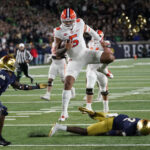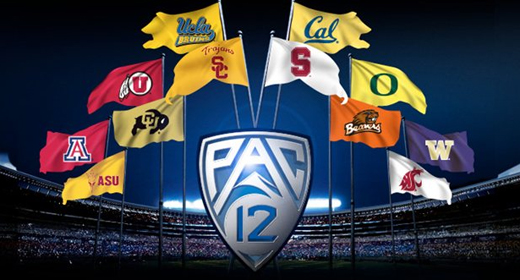The Hotline mailbag is published every week. Send questions to pac12hotline@bayareanewsgroup.com and include ‘mailbag’ in the subject line or hit me on Twitter: @WilnerHotline.
Some questions have been edited for clarity and brevity.
Are Washington and Oregon the key to survival? Even if Colorado and Arizona leave for the Big 12, the Pac would survive if Oregon and Washington stay, correct? — @bartskee33
As long as Oregon and Washington are willing to sign a grant-of-rights agreement, the conference will exist in some fashion, although it could look more like the Pac-8 or its mid-20th century predecessor, the AAWU (Athletic Association of Western Universities), than the version we have come to know.
Since the announced departures of USC and UCLA last summer, the Hotline has defined Pac-12 survival as the existence of the conference in recognizable form — the form it has taken for the last four-plus decades. That is, with the Arizona schools.
Colorado isn’t essential to that outcome. If the Buffaloes were to bolt for the Big 12, the Pac-12 could simply replace them with San Diego State and carry on. (We consider CU more likely to remain in the Pac-12 than leave, but until there’s a deal, all scenarios must be considered.)
In our view, the Arizona schools hold the key to a recognizable Pac-12.
Would Colorado’s departure trigger the Sun Devils and Wildcats to leave, as well?
And would they move together? They share a board of regents, after all. But so, too, did Cal and UCLA.
Our sense is the Arizona regents would compel the schools to remain paired. That could pose an interesting dynamic if, for instance, ASU president Michael Crow wanted to stay and Arizona’s Robert Robbins preferred to leave.
We are a long way from that issue moving to the forefront. But survival is not about Colorado leaving; it’s about the impact Colorado leaving would have on the Arizona schools and, potentially, Utah.
Currently, we believe the Arizona schools would be more likely to remain than depart in the event CU bolts, although the chance isn’t much higher than 50 percent in that situation.
What are the Hotline’s latest survival odds for the Pac-12? — @KyleMaloy2
Despite all the smoke emanating from Boulder and the Big 12, the Hotline’s odds remain unchanged: Pac-12 survival is a 4-point favorite over Pac-12 extinction.
That translates to a roughly 60 percent probability of the conference remaining intact.
In other words: Survival is more likely than extinction.
Fans want the situation painted in black and white. But realignment, like Omar Little, our favorite character from ‘The Wire,’ is mostly gray.
Still believe the Pac-12 media deal is better or equal to the one the Big 12 signed? — @dawgvegas1
The Hotline’s three foundational positions have not changed since July:
1) The Big Ten is unlikely to expand again before the new media contract expires.
2) The Pac-12 schools would prefer to remain together.
3) The Pac-12 and the Big 12 carry comparable media valuations.
How do we define comparable? Within roughly 10 percent of each other.
Given that the Big 12’s deal works out to $31.7 million per school per year, that pegs the Pac-12’s valuation in the $28 million to $35 million range.
And guess what: Their current deals track with that projection.
The Pac-12’s agreement with ESPN and Fox averages $20.8 million while the Big 12’s deal with ESPN and Fox averages $22 million — a difference of 5.5 percent.
Yes, Texas and Oklahoma were worth more to the Big 12 than USC and UCLA were worth to the Pac-12, but the Big 12 also added schools that expanded its footprint and improved its market reach.
So we are probably back where we started, with the leagues having similar valuations.
Shouldn’t Pac-12 commissioner George Kliavkoff come out and say something at this point? Even if it’s not great news? His complete silence and hiding are making him look like an ineffective leader. — @troyboy8ball
This has been an ongoing topic of debate inside and outside the conference for months.
Kliavkoff undoubtedly views radio silence as the approach that best serves his bosses (the presidents) and his negotiating partners.
But the absence of messaging from the person leading the negotiations, combined with the length of time required for resolution, created a vacuum filled by rumor, speculation and destabilization efforts.
Could those rumors prompt the Pac-12 presidents to lose faith in the process and, consequently, Kliavkoff’s leadership?
We’ll have an answer when the saga concludes.
Will conferences look at jettisoning poor performing schools besides adding schools? Nebraska has sucked since joining the Big Ten, and Vanderbilt has been a non-factor in the SEC for years. — @A_C_Taylor
I am not aware of any major conference booting a member for poor performance, and there’s no reason to expect the expulsion process to begin soon, anywhere.
That said, college football will look much different in 10 or 20 years. We could very well see the Power Five broken into tiers, with 30-35 heavyweights participating in a Saturday version of the NFL.
Why? Because subsidization lies at the heart of college sports:
— The elite football programs subsidize the rest of the Power Five.
— The Power Five subsidizes the rest of the Football Bowl Subdivision.
— The Football Bowl Subdivision subsidizes the rest of Division I.
— Division I subsidizes the other NCAA divisions.
The NCAA has more than 1,000 members, but only 15-20 provide the rocket fuel. That’s one of the reasons — perhaps the essential reason — why the college sports world is so screwed up.
Are the Big Ten and NBC colluding by having games like Washington-Michigan State on a streaming-only platform (Peacock) to further devalue the Huskies and Oregon? They could then point to the streaming numbers of this game as evidence to justify offering them a smaller share down the road? — @Al_Avina
That is one heck of a conspiracy theory, but I have zero reason to believe it carries any validity.
NBC wants to push viewers to Peacock through its agreement with the Big Ten and is using big games and brand names to achieve the goal.
It’s not placing the Huskies on Peacock to devalue their revenue share for possible Big Ten membership years down the road.
And we should note that games involving Michigan and Penn State will be shown exclusively on Peacock in the early weeks of the season.
This is the future, folks. Once ESPN moves to streaming in a few years, the rate of acceptance will accelerate.
If the Pac-12 signs a less-than-optimal media deal, would it likely be announced on a Friday, weekend, or holiday? (Or some kind of inverse if it’s good news?) Would there otherwise be anything to read into the timing of a news release? — Alex Fox
If I understand the question correctly, you’re wondering if the conference would go public Monday through Thursday with a deal worth more than the Big 12’s agreement but on Friday (or the weekend) if the deal is worth less.
I cannot imagine a scenario in which the valuation frames the timing of an announcement.
The conference has avoided major leaks thus far, in part because of Kliavkoff’s extremely tight circle of advisers and confidantes. But when (if) a deal is finalized, the news is more likely to become public through leaks to anonymous sources in the media than through a formal announcement by the Pac-12.
And those leaks could very well originate with one of the media companies involved, not someone affiliated with the Pac-12.
Any truth to this statement: “Colorado has been in ‘substantive’ talks with the Big 12 about possibly joining the growing league, a source with knowledge of the discussions tells CBS Sports.” — @BruinStrmShadow
I won’t comment on any specific media report rooted in anonymous sources and subjective descriptions of events. (For example, how do you define “substantive”?)
But generally speaking, the Hotline has assumed all along that Colorado, Utah and the Arizona schools were engaged, to varying degrees, in membership discussions with Big 12 representatives.
Given the length of time required for the Pac-12’s media negotiations, the schools must perform due diligence. They owe it to their athletes and fans to have a suitable landing spot.
Also, it’s realignment. Everybody is talking to everybody.
I have read quotes from numerous Pac-12 leaders that have said their order of business is to 1) finalize the media rights deal, 2) get the grant-of-rights signed, then 3) focus on expansion. Practically speaking, don’t they have No. 1 and 3 backwards? Wouldn’t the Pac-12’s media partners want to know exactly what they are getting and paying for? — Wayne Niebroski
They would, for sure.
Understandably, this issue has confounded fans over the months-long process. Yes, the media partners would want some sense of the membership structure given the role brand value, media markets and game inventory have on valuation.
As a result, triggers could be baked into the agreement: The Pac-12 would receive X dollars as a 10-school league and Y dollars if larger.
Look at the issues as three airplanes that must prepare for arrival at the same time but with a single runway available. Kliavkoff would agree to a media rights deal, present it to the presidents for approval (the grant-of-rights piece), then call a formal vote on expansion.
The conference won’t announce a media deal unless the grant-of-rights deal has been signed, but it could take a few days for the formal expansion announcement given the legal documents involved.
At least, that’s how we envision the process unfolding.
Does the @seattletimes still buy and publish your syndicated column? — @KSea5
Our syndication partners have access to every article published and full control over which ones they use. There are no requirements on their end. The decisions are based on circumstances particular to each outlet.
If you have questions or general comments about their use of Hotline content, my suggestion is to reach out to them directly. And be sure to thank them. We treasure the relationships.
Why did you unblock me? — @BearcatMta
For the record, the Hotline has only blocked two accounts on Twitter, ever, and neither has subsequently been unblocked.
One block was simply a functionality issue. We were tagged by the account in such a way that it clogged up my notifications on Tweet Deck and made reading them far too difficult.
The other block was for content. The account passed along Alex Jones’ conspiracy theories on the Sandy Hook shooting.
Otherwise, nobody has been blocked.
The Hotline views Twitter like a sports bar. Once I enter, the patrons can ignore me, converse with me or yell at me. As long as nobody gets personal, folks are free to say (or scream) whatever they want.
*** Send suggestions, comments and tips (confidentiality guaranteed) to pac12hotline@bayareanewsgroup.com or call 408-920-5716
*** Follow me on Twitter: @WilnerHotline
*** Pac-12 Hotline is not endorsed or sponsored by the Pac-12 Conference, and the views expressed herein do not necessarily reflect the views of the Conference.
Related posts:

(AP Photo/Ralph Freso, File)
College Football Playoff expansion to begin in 2024 after Rose Bowl relents: Early start a boost for the Pac-12
(AP Photo/Marcio Jose Sanchez)
Pac-12 media rights negotiations: Waiting for UCLA, and welcoming Deion Sanders The Pac-12 top 10: Key storylines from a wild week of staff hires, player departures, AD tweets
The Pac-12 top 10: Key storylines from a wild week of staff hires, player departures, AD tweets 
Clemson quarterback DJ Uiagalelei (AP Photo/Charles Rex Arbogast)
Pac-12 football: 2023 should be the Year of the QB as Oregon State adds an intriguing talent
